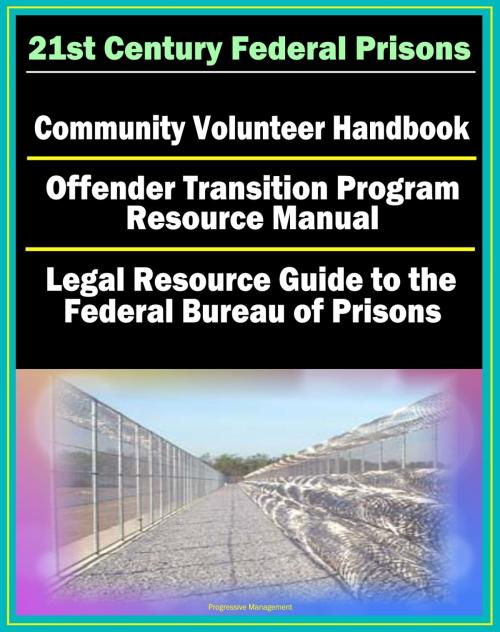21st Century Federal Prisons: Community Volunteer Handbook, Offender Transition Program Resource Manual (Jobs, Assistance), Legal Resource Guide to the Federal Bureau of Prisons, Imprisonment
Nonfiction, Health & Well Being, Self Help, Addiction, Substance Abuse, Business & Finance, Career Planning & Job Hunting, Careers| Author: | Progressive Management | ISBN: | 9781458020703 |
| Publisher: | Progressive Management | Publication: | May 4, 2011 |
| Imprint: | Smashwords Edition | Language: | English |
| Author: | Progressive Management |
| ISBN: | 9781458020703 |
| Publisher: | Progressive Management |
| Publication: | May 4, 2011 |
| Imprint: | Smashwords Edition |
| Language: | English |
This ebook presents a compilation of authoritative documents from the Federal Bureau of Prisons (BOP): Community Volunteer Handbook; Offender Transition Program Resource Manual; Legal Resource Guide to the Federal Bureau Of Prisons.
Community Volunteer Handbook: Prepared by the Inmate Transition Branch, this handbook is designed to assist those who volunteer to provide services to offenders during their incarceration in federal correctional institutions. These institutions, all part of the Federal Bureau of Prisons (BOP), are located at over 100 locations throughout the United States, some in major metropolitan areas like New York and Chicago, and others in smaller communities like Manchester, KY, and Gilmer, WV. Wherever they serve, volunteers can help to accomplish the BOP s mission: It is the mission of the BOP to protect society by confining offenders in the controlled environment of prisons and community-based facilities that are safe, humane, cost-efficient and appropriately secure, and that provide work and other self-improvement opportunities to assist offenders in becoming law-abiding citizens. As of April 2006, over 190,000 offenders were serving time in federal custody. The Bureau operates institutions at five different security levels in order to confine offenders in an appropriate manner. Security levels are based on such features as the presence of external patrols, towers, security barriers, or detection devices; the type of housing within the institution; internal security features; and the staff-to-inmate ratio. Each facility is designated as either minimum, low, medium, high, or administrative. The opportunities for volunteers to serve are both rewarding and varied, and can be designed to meet their personal qualifications and time schedules. However, they will need to meet the security and related requirements of the federal prison system. This handbook will describe these requirements and help each volunteer meet them in a timely and efficient manner.
Offender Transition Program Resource Manual has lists of resources, career exploration, general assistance programs, business and consumer education, substance abuse and mental health, and more. It is a particularly useful document for job seekers.
Legal Resource Guide to the Federal Bureau of Prisons is intended to serve as a guide to legal resources, including relevant statutes, regulations, policy documents, and current case law concerning issues the BOP faces today. It provides a general overview of the BOP, its services, and its programs. Contents include: Pretrial Issues, Pretrial Detention, Pretrial Inmate Health Care, Evaluation of Offender Mental Capacity, Sentencing Issues, Probation and Condition of Probation, Imprisonment, Judgment and Commitment Orders, Post Conviction Issues, Programs and General Services, Work Programs, Reliqious Programs, Substance Abuse Treatment, Urine Surveillance, Medical Services, Mental Health Counseling, Visiting, Telephones, and Correspondence, Discipline Procedure, Inmate Access to Court, Administrative Remedy Programs, Personal Property, Special Administrative Measures, Family Emergencies and Temporary Releases, Release, Community Notification, and more.
This is a privately authored news service and educational publication of Progressive Management.
This ebook presents a compilation of authoritative documents from the Federal Bureau of Prisons (BOP): Community Volunteer Handbook; Offender Transition Program Resource Manual; Legal Resource Guide to the Federal Bureau Of Prisons.
Community Volunteer Handbook: Prepared by the Inmate Transition Branch, this handbook is designed to assist those who volunteer to provide services to offenders during their incarceration in federal correctional institutions. These institutions, all part of the Federal Bureau of Prisons (BOP), are located at over 100 locations throughout the United States, some in major metropolitan areas like New York and Chicago, and others in smaller communities like Manchester, KY, and Gilmer, WV. Wherever they serve, volunteers can help to accomplish the BOP s mission: It is the mission of the BOP to protect society by confining offenders in the controlled environment of prisons and community-based facilities that are safe, humane, cost-efficient and appropriately secure, and that provide work and other self-improvement opportunities to assist offenders in becoming law-abiding citizens. As of April 2006, over 190,000 offenders were serving time in federal custody. The Bureau operates institutions at five different security levels in order to confine offenders in an appropriate manner. Security levels are based on such features as the presence of external patrols, towers, security barriers, or detection devices; the type of housing within the institution; internal security features; and the staff-to-inmate ratio. Each facility is designated as either minimum, low, medium, high, or administrative. The opportunities for volunteers to serve are both rewarding and varied, and can be designed to meet their personal qualifications and time schedules. However, they will need to meet the security and related requirements of the federal prison system. This handbook will describe these requirements and help each volunteer meet them in a timely and efficient manner.
Offender Transition Program Resource Manual has lists of resources, career exploration, general assistance programs, business and consumer education, substance abuse and mental health, and more. It is a particularly useful document for job seekers.
Legal Resource Guide to the Federal Bureau of Prisons is intended to serve as a guide to legal resources, including relevant statutes, regulations, policy documents, and current case law concerning issues the BOP faces today. It provides a general overview of the BOP, its services, and its programs. Contents include: Pretrial Issues, Pretrial Detention, Pretrial Inmate Health Care, Evaluation of Offender Mental Capacity, Sentencing Issues, Probation and Condition of Probation, Imprisonment, Judgment and Commitment Orders, Post Conviction Issues, Programs and General Services, Work Programs, Reliqious Programs, Substance Abuse Treatment, Urine Surveillance, Medical Services, Mental Health Counseling, Visiting, Telephones, and Correspondence, Discipline Procedure, Inmate Access to Court, Administrative Remedy Programs, Personal Property, Special Administrative Measures, Family Emergencies and Temporary Releases, Release, Community Notification, and more.
This is a privately authored news service and educational publication of Progressive Management.















